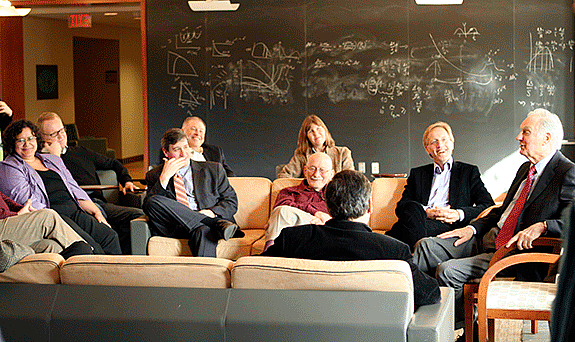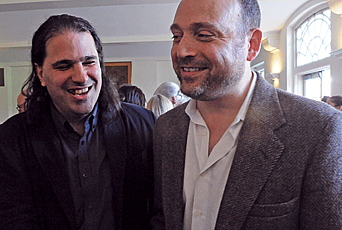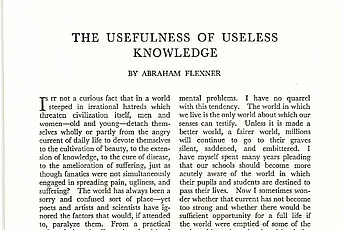A Room, an Office, a Library, a World

The Institute is a remarkably modest place. Like all Members of the School of Historical Studies, I was provided a lovely apartment, a simple office (with computer), access to both the Institute’s libraries and those of Princeton University, lunch in the dining hall, tea in the afternoon. So how does new knowledge come out of such a simple mix? Juxtaposition! So much of the wealth of insight I’ve had this year (and there’s been a lot of it) has come from the chance conversations, the oblique reference in a lecture, the reference exchanged in the hallway.
The world of scholarship is a very different place than when I was a Member here for the first time in 1990–92. There was an Internet then, I suppose, but I was not yet a user. I was not yet using email, there was no Google, no online digital reproductions of unique medieval manuscripts that I could call up for viewing within seconds, rather than having to travel thousands of miles to get to distant libraries during their rare opening hours or buying expensive films that had to be strung up on a microfilm viewer (ugh!) for long, eyeball-shrinking, mind-numbing sessions. So much of the world of knowledge is now at my fingertips; I can go for hours without ever leaving my desk. So what is the value of the IAS in such a hyper-connected world? Even more than twenty years ago, I found that the richness of this place lies in the human interactions, the analogueness (if you will) of life at this community in the woods.
Much of my work this year has been in collaboration with scholars elsewhere, building on projects already many years in the making. But my work and theirs has been infinitely enriched by the daily stimuli I’ve had from my colleagues here at IAS. Here are a few vignettes.
Even before I arrived last fall, I went through the list of scholars who would be here both in Historical Studies and Social Science. Lady Mungo jumped out at me. Lady Mungo is the name given to an Australian Aborigine who likely lived between 40,000 and 50,000 years ago. I’ve been moving my work on the history of human disease into “deep time” and the early peopling of the Earth has been on my radar. Ann McGrath, from the Australian National University, was coming into the School of Social Science to do a study on Lady Mungo. So I made contact via email last summer, and we were all ready to talk once we arrived in September.
The last lecture I went to this year was also in Social Science and also looking at a very big picture. This was a lecture on “Six Ways of Looking at the Anthropocene” by Joseph Masco in the School of Social Science, a look at a very recent art installation that tried to capture the impacts humans have had on Earth, to the point of becoming a geological epoch in our own right. Between the Pleistocene and the Anthropocene, there was every other element of human history on hand this year. I only went to a fraction of the talks and seminars I would have liked to, but even those boggle my mind as I look back on my packed calendar of the last few months.
Nor were my stimuli limited to my most closely allied fields in history and anthropology. A recent innovation here at IAS is “After Hours Conversations.” The format is fixed: ten minutes of talk (no notes, no slides), followed by twenty minutes of open discussion. (Oh, and drinks. The sessions are held at Harry’s Bar.) Talks ranged from “Origins of Life” (Piet Hut) and “Terrorism and the World-Wide Web of Interdiction” (Kim Scheppele) to “Why Petroleum Did Not Save the Whales” (Richard York) and “Category Theory” (David Spivak). I even gave my own talk, “Scales of Time and Space in Global Health: Getting Historians and Geneticists on the Same Page,” which was a welcome opportunity for me to riff on why the notions of “working at scale” that have been pioneered by global historians can be so fruitful in finding common ground between different disciplines.
But perhaps even more valuable to me, beyond the formal lectures or even informal talks, were the chance encounters—the tips about a new article, a new method, a different insight that came over lunch, at tea, or in the hallway. The best (because so unexpected) were those that came from people working on topics far distant in time or place or method from my own. I had been to David Pankenier’s talk, for example, on his work on ancient Chinese astronomy in the fall. “Fascinating work,” I thought. “Who knew that dragons could have such significance?” But it had no connection to my own work on medieval medicine.
But then, in January, when all of us in Historical Studies were reintroducing ourselves to the new crop of scholars who had just arrived, David said that now he was working on the dust-veil event of the early sixth century, which might, he suggested, have been an asteroid rather than (as has commonly been believed) a volcanic eruption.
“Well, that’s no closer to medieval medicine than ancient astronomical dragons,” you may be thinking. But in fact, bells were ringing and lightbulbs flashing in my head when David said those words. For by January, my interests had finally turned to a volume of collected essays I was editing “on the side” of all my other projects. My topic? The Black Death—a rethinking, in fact, of nearly everything we thought we knew about the great medieval pandemics of plague. This rethinking had been prompted by new work in the genetics of Yersinia pestis (the plague pathogen) in the past decade and a half. And genetics connects to astronomy because there may be reason to think that what pushed Y. pestis into new ecosystems in the sixth and fourteenth centuries (the explosive beginnings of the two medieval pandemics) were climatic events. David kindly joined me when I presented on the plague at the medieval seminar later that month, which in turn gave me the nudge I needed to finish my own contribution to the volume. The sixth-century asteroid doesn’t figure there because I was focusing on the fourteenth century only. But China does, because of yet another IAS connection.
Stephen West, also in the East Asia group but a regular guest among the “Western” medievalists, cyber-introduced me to a colleague at Columbia, who joined the contributors to my volume of essays on the Black Death. Those essays will be appearing in a journal called, fittingly enough, The Medieval Globe. And that, really, sums up the beauty of this place: the whole world truly is brought together here, making that plain little office of mine a window out onto a universe of learning.

